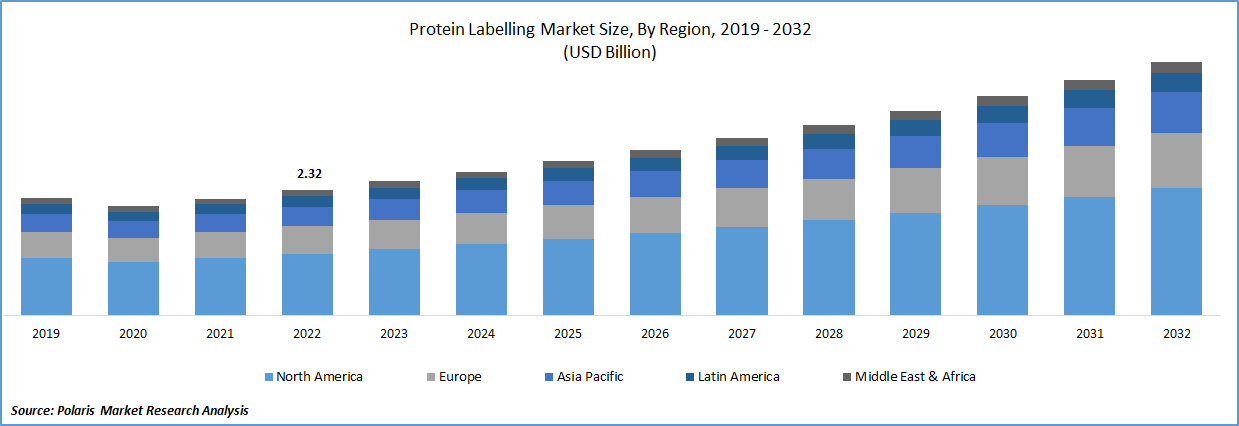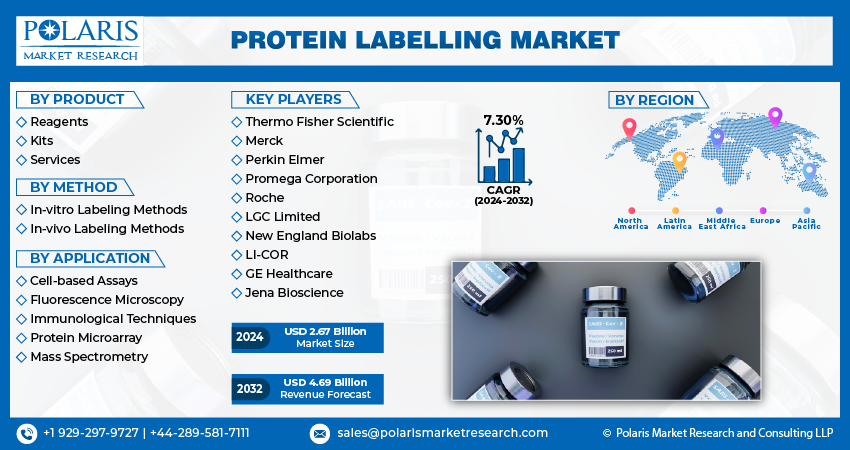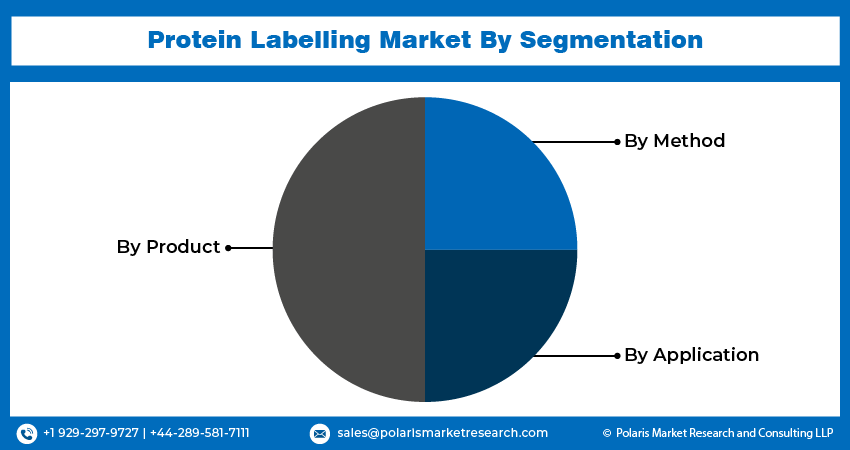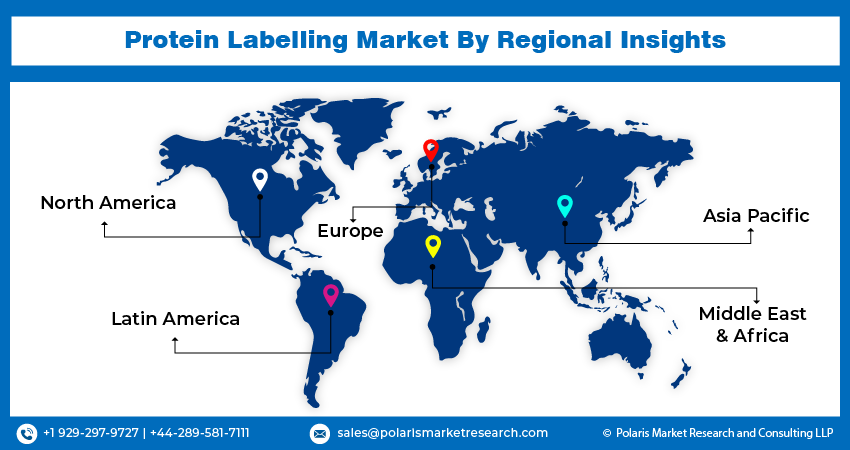
Protein Labelling Market Share, Size, Trends, Industry Analysis Report, By Product (Reagents, Kits, Services); By Method; By Application (Mass Spectrometry, Cell-based Assays, Fluorescence Microscopy, Immunological Techniques, Protein Microarray); By Region, And Segment Forecasts, 2024 - 2032
- Published Date:Jan-2024
- Pages: 119
- Format: PDF
- Report ID: PM3552
- Base Year: 2023
- Historical Data: 2019-2022
Report Outlook
The global protein labelling market was valued at USD 2.49 billion in 2023 and is expected to grow at a CAGR of 7.30% during the forecast period. Adoption of modern molecular biology & bioengineering tools has revolutionized the study of functional mechanisms on a subcellular scale. This has led to significant improvements in drug development, diagnosis, and therapy applications. With the use of bioengineering tools, the usage of protein labeling in the detection and purification of proteins has increased significantly.

To Understand More About this Research: Request a Free Sample Report
Protein labeling is a critical technique for the identification and analysis of proteins in biological systems. It involves the covalent attachment of a label, such as a fluorescent dye or radioactive isotope, to a protein of interest, which allows for its detection and purification. With the advancements in bioengineering tools, the development of new and improved labeling methods has become possible, allowing for more accurate and efficient protein analysis.
Proteomics is a rapidly evolving field that focuses on the study of proteins and their functions within biological systems. Rise in R&D for proteomics research has been driven by the growing demand for protein analysis techniques, which has led to the development of innovative protein labeling techniques. These techniques have greatly expanded the applications of mass spectrometry, protein microarray, & biochips in the field of proteomics.
Mass spectrometry is a powerful tool for protein analysis that has been widely adopted in proteomics research. Recent innovations in the workflows have allowed for the analysis of complex protein mixtures with higher sensitivity and accuracy, which has greatly enhanced the capabilities of this technique in proteomics applications.
Protein microarrays and biochips are also important tools in proteomics research, as they allow for the simultaneous analysis of multiple proteins in a high-throughput manner. The miniaturization of these technologies has allowed for the analysis of smaller sample volumes and has increased the speed and efficiency of protein analysis workflows.
However, there are also potential roadblocks to protein labelling market expansion. One of the main challenges is the lack of experienced specialists who are trained in protein labeling techniques. This has created a skills gap that needs to be addressed in order to fully realize the potential of this technology. Another challenge is the limited uses of protein labeling goods, which can limit their applicability in certain research areas. In addition, the high costs of reagents, kits, and other protein labeling services can be a barrier to entry for some researchers and companies.

Industry Dynamics
Growth Drivers
Protein labeling is an important technique used in proteomics research for studying protein structure, function, and gene function. The market for protein labeling has been strengthened by the introduction of new technology, which has led to the development of more advanced and efficient labeling methods. This has allowed for more accurate and reliable analysis of proteins, which is crucial for research and diagnostic purposes in the biotechnology and pharmaceutical industries.
The growing prevalence of chronic diseases such as cancer has led to an increasing demand for disease prevention, diagnosis, and treatment. Protein labeling techniques play a crucial role in the development of new drugs and therapies for these diseases, which is expected to drive the growth of the market.
Report Segmentation
The market is primarily segmented based on product, method, application, and region.
|
By Product |
By Method |
By Application |
By Region |
|
|
|
|
To Understand the Scope of this Report: Speak to Analyst
Reagents Segment Accounted for the Largest Market Share in 2022
Reagent segment is a significant contributor in the market, with a rising number of labeling agents, leading to an increase in market share. Availability of gold standard reagents, such as the “No-Stain Protein Labeling Reagent”, which enables reliable protein visualization & normalization, has a positive impact on the growth of this segment. Availability of labeling reagents with varied labeling chemistries has further contributed to the growth of this segment. This has enabled researchers to choose the most suitable reagent for their specific research needs, leading to increased demand for protein labeling reagents.
Kits segment recorded the steady growth rate over the study period. Segment’s growth is primarily due to development of various kits to label membrane peptide molecules for super-resolution microscopy is a significant advancement in the protein labeling market. Super-resolution microscopy is a technique that allows for imaging of cellular structures with much higher resolution than traditional microscopy methods. Labeling membrane peptide molecules using these kits enables researchers to visualize and study these structures in greater detail, which has numerous applications in drug discovery and development, as well as basic research.
Immunological Techniques Segment Held the Significant Market Revenue Share in 2022
Immunological techniques segment held the maximum market share in terms of revenue in 2022. Immunological techniques such as flow cytometry, immunoassays, western blotting, and immunofluorescence are commonly used in various fields of research, including cancer research, autoimmune disease research, and drug development. These techniques typically involve the use of labels, such as fluorescent dyes, enzymes, or radioisotopes, to detect and quantify specific proteins or other biomolecules of interest.
Fluoroscopy microscopy segment recoded steady growth rate. This growth is driven by the increasing adoption of high-throughput fluorescence microscopy in academic research, as well as the development of new imaging technologies and analysis tools.

North America Region Dominated the Global Market in 2022
The North America region dominated the global market with considerable market share. Region’s high adoption of protein labeling techniques in disease diagnosis-associated studies is also a major driver of revenue generation. The prevalence of chronic diseases such as cancer, cardiovascular diseases, and neurological disorders has increased significantly in North America in recent years. As a result, there is a growing need for accurate and reliable diagnostic tools to detect and monitor these diseases. Protein labeling techniques play a crucial role in the development of such diagnostic tools, as they enable the detection and quantification of specific proteins in patient samples.
A research study conducted by the National Institutes of Health in the U.S. in August 2019 introduced a bi-arsenical dye system that enables the fluorescent detection of proteins in various cellular locations. This innovative technology has opened new opportunities for studying the morphology and motility of Borrelia and Leptospira species, which are responsible for causing Lyme disease and leptospirosis, respectively. The application of this technology has broadened the scope of protein labeling techniques in disease diagnosis and research
The Asia Pacific region is expected to be the fastest growing region with a healthy CAGR over the study period. The increasing prevalence of chronic diseases in these countries, coupled with the growing demand for personalized medicine, is driving the adoption of protein labeling techniques for disease diagnosis and treatment. Furthermore, the presence of many contract research organizations (CROs) in the region is also contributing to the growth of the region.

Competitive Insight
The protein labeling market is highly competitive, with both smaller and larger companies vying for market share. Smaller companies are entering the market with customized protein labeling kits that cater to the specific needs of researchers. This allows them to differentiate themselves from larger companies and capture a niche market. On the other hand, larger companies are focusing on new product launches to cater to the needs of researchers. They have the advantage of larger R&D budgets, which allows them to invest in the development of new and innovative labeling technologies.
Some of the major players operating in the global market include Thermo Fisher Scientific, Merck, Perkin Elmer, Promega Corporation, Roche, LGC Limited, New England Biolabs, LI-COR, GE Healthcare, and Jena Bioscience.
Recent Developments
- In January 2023, SCIEX has expanded its portfolio of offerings with the introduction of 1st glycan labelling & analysis kit, offering rapid identification & analysis of the concerned glycans sample.
Protein Labelling Market Report Scope
|
Report Attributes |
Details |
|
Market size value in 2024 |
USD 2.67 billion |
|
Revenue forecast in 2032 |
USD 4.69 billion |
|
CAGR |
7.30% from 2024 – 2032 |
|
Base year |
2023 |
|
Historical data |
2019 – 2022 |
|
Forecast period |
2024 – 2032 |
|
Quantitative units |
Revenue in USD billion and CAGR from 2024 to 2032 |
|
Segments covered |
By Product, By Method, By Application, By Region |
|
Regional scope |
North America, Europe, Asia Pacific, Latin America, Middle East & Africa |
|
Key companies |
Thermo Fisher Scientific, Merck, Perkin Elmer, Promega Corporation, Roche, LGC Limited, New England Biolabs, LI-COR, GE Healthcare, and Jena Bioscience |
FAQ's
The protein labelling market report covering key segments are product, method, application, and region.
Protein Labelling Market Size Worth $4.69 Billion By 2032.
The global protein labelling market is expected to grow at a CAGR of 7.3% during the forecast period.
North America is leading the global market.
key driving factors in protein labelling market are Increase In Technological Advancements In The Market.
